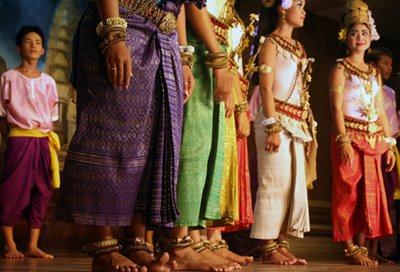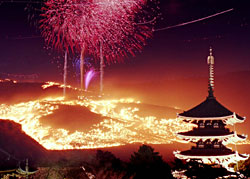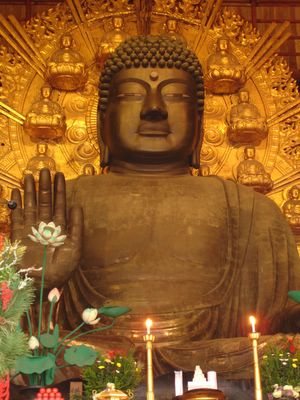Things I will never forget: La's smile.
I've been putting off this post because I realized I am missing the CD of pictures I took at Ta Prom and the Bayon. I kept hoping it would magically materialize in my bookbag or under one of the many piles of junk accumulating in my apartment, but deep down, I know exactly where it is: On a computer in a Siem Reap interent cafe. (ioi) Saddness. At least I have my memories, and a comforting feeling that I will see these children again.
The way Ba scrambled up and over the crumbling ruins of the temples without any shoes.
When I first met Ba, he was hiding behind a moss colored sandstone wall, crouching among the piles of stones thrown down by the crushing roots of the Banyon trees. Like me, he seemed to be hinding from the few remaining tour groups rushing through the temple grounds, hurrying behind tour guides leaving echos of Spanish, Italian, French, Japanese and German echoing through the quiet courtyard. I sat alone in silence for awhile before I noticed him peaking out at me, only to take cover when I looked up at him. I began playing a game of peek-a-boo, which brought an adorabley beautiful smile to his dirt-smudged face. It was getting late, and the last of the tourists had long since passed through our secret courtyard, but I wasn't quite ready to leave this beautiful boy all alone.
"Are you hungry?" I asked, assuming he'd understand an exaggerated gesture of me scooping food into my mouth. He giggled. "You. Me. Yum yum?" He shook his head no and climbed back up on the rocks. "Oh, come on Ba! (We had been though the name and age formalities) I know your hungry! Let's go!" He scrambled up over the rocks and disappeared. I was sad to see him go, and sat down on the rocks again hoping he'd come back.
It didnt take long before he reappeared, popping his head out of a darkened doorway with his two friends La and Run close behind. He pointed at me, I assume telling his friends something along the lines of "This is that strange foreigner I was telling you about," although I cant be sure because it was in Khmer. "Come on!" He called to me smiling, ushering me into the darkness with the wave of his hand.
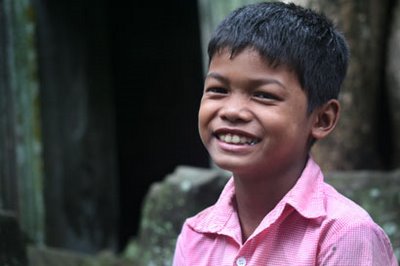
The way Run repeated everything I said, and then busted out into laughter that echoed through the temple courtyrads and chambers.
They led me through the shadow-filled halls of the temple, through tiny cracks and holes showing me hidden apsaras immortalized in stone. Through a small opening of tumbled stone they led me to a narrow chamber, pointing out the small, strangled head of a buddha peaking out through the tangled tree roots. The guided me through the temple laughing and playing with me, smiling all the way, trying their best to communicate in any way they could.
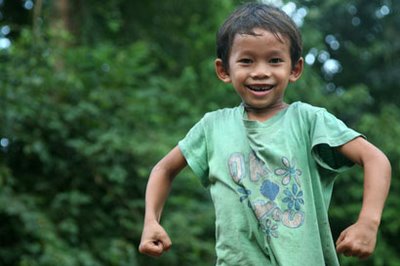
The pure joy of playing.

Getting to know the children: talking, laughing and playing with them. Learning about their lives, their families, their hopes and dreams...
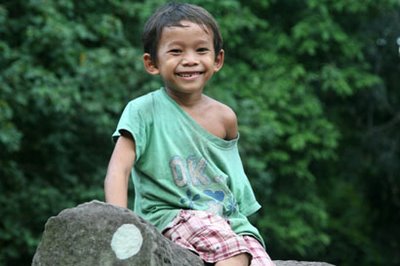
Being able to make them smile so easily, and hearing them laugh.
By the time we left the temple it was almost 6 O' clock. I asked Ba, La and Run where they would like to eat, and they led me to a small stall staffed by a single woman with a huge smile on her face. She spoke very good English, and I told her to give the boys whatever they wanted. A small crowd of children had gathered around me, and were looking up at me with big, hungry eyes. "Madame, yum yum?"
"How much for these kids, too?" I asked her.
"Hmmm," she thought, perhaps struggling to choose between the chance to make a killing off a foreigner or help feed the children. "7 dollars."
"7 dollars? For how many kids?" Looking behind me the crowd had grown considerably. I opened up my wallet. All I had was $12 lousy bucks.
"Hmmm...12 kids."
"How many are there here?" I asked, trying to number the beautiful little faces swirling around me. She shouted out numbers in Khmer to the children, checking to make sure no one was counted twice.
"26." She announced when she was sure she had counted right.
"26?!" I frowned. " I have 12 dollars. Look. I swear its all I have!" I showed her my empty change purse, pulling out my pockets.
"Hmmm..." She thought to herself, looking around at the kids.
"How can I choose only 12 of them?" I asked her, with sincere tears welling up in my eyes. (I swear Im not usually this emotional). "You do it. I cant choose."
"Ok. Ok." she smiled after a long silence. "Khmer price. 12 dollars, everyone eats!" Khmer price or not, sounded like a deal to me.
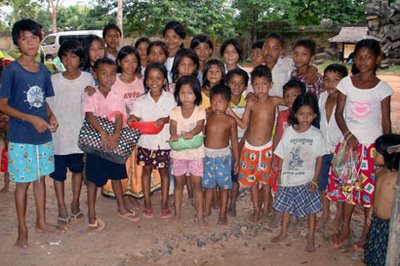
26 of the children from the nearby villages get ready for some yum-yum (^-^)/



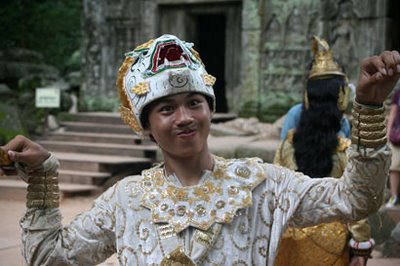


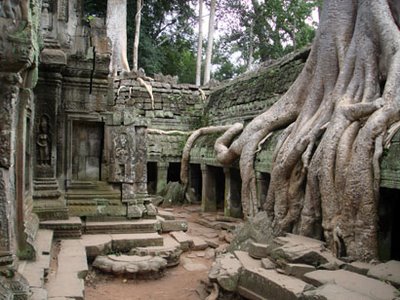

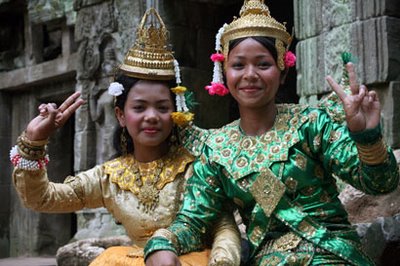
 My first visit to
My first visit to 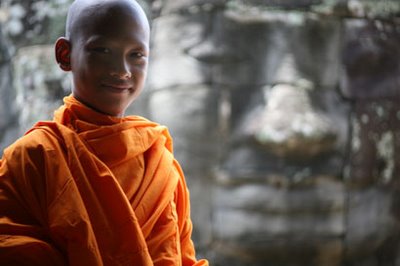






 Getting to know the children: talking, laughing and playing with them. Learning about their lives, their families, their hopes and dreams...
Getting to know the children: talking, laughing and playing with them. Learning about their lives, their families, their hopes and dreams...
 26 of the children from the nearby villages get ready for some yum-yum (^-^)/
26 of the children from the nearby villages get ready for some yum-yum (^-^)/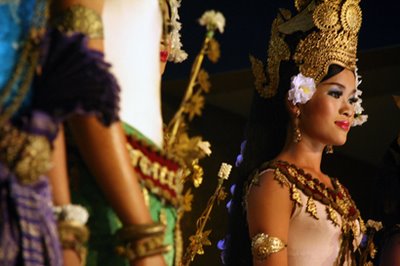 Classical Cambodian ballet is a stunningly graceful, 2,000-year-old blend of sinuous hand gestures and sensuous body movements, all deep with meaning. The graceful movements of the Apsara dancers, adorned with brilliant gold headdresses and colorful, silk tunics and skirts, are carved on the walls of many of the temples at Angkor. Estimates are that there were 3,000 Apsara dancers in the 12th century court of King Jayavarman VII.
Classical Cambodian ballet is a stunningly graceful, 2,000-year-old blend of sinuous hand gestures and sensuous body movements, all deep with meaning. The graceful movements of the Apsara dancers, adorned with brilliant gold headdresses and colorful, silk tunics and skirts, are carved on the walls of many of the temples at Angkor. Estimates are that there were 3,000 Apsara dancers in the 12th century court of King Jayavarman VII.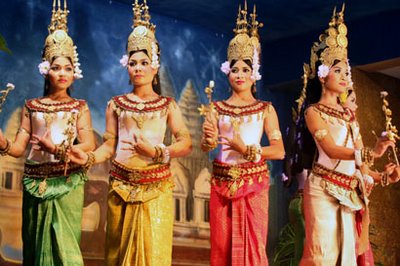
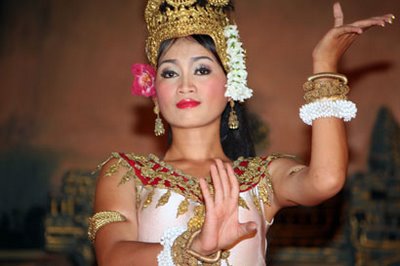 The Apsara tradition was devastated by the Pol Pot years. Dancers were killed in large numbers as symbols of bourgeoise excess, and only a few instructors survived to keep the ancient tradition alive.
The Apsara tradition was devastated by the Pol Pot years. Dancers were killed in large numbers as symbols of bourgeoise excess, and only a few instructors survived to keep the ancient tradition alive.


